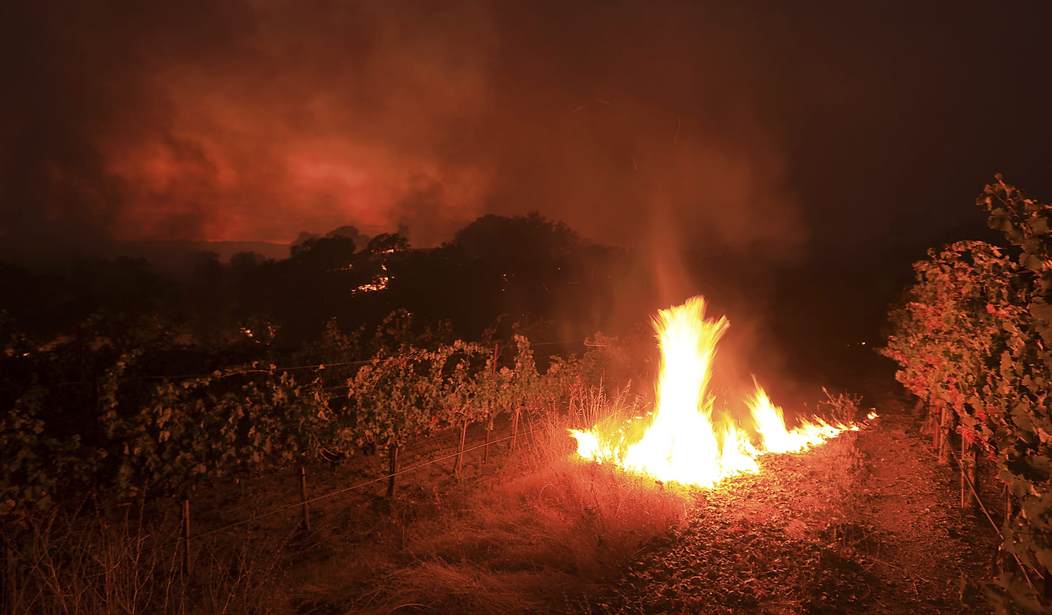The Islamic State included a report on the California wildfires in the news briefs section of their weekly newsletter, noting the property damage estimates and death toll of blazes that were the “worst in the history” of the state.
ISIS, which has encouraged followers to try arson as a terror tactic, did not take credit for starting any of the blazes.
“Strong winds hindered the efforts” in fighting the blazes, the terror group noted in al-Naba, a 16-page color newsletter distributed within ISIS territory and online as a PDF, while citing California Department of Forestry and Fire Protection as saying some bodies had been burned beyond recognition and would be difficult to identify. “Thousands of people became homeless,” ISIS said, adding stats from earlier in the week on “the most destructive fire in the history of the state.”
This past January, ISIS’ Rumiyah magazine — which is published in multiple languages including English — stressed to would-be jihadists that “incendiary attacks have played a significant role in modern and guerrilla warfare, as well as in ‘lone wolf’ terrorism,” claiming a November fire at a furniture factory in Losino-Petrovsky, Russia, and highlighting scores of wildfires around Israel that month as incidents that “demonstrated the lethality of such an effortless operation.”
Suggested target locations for arson attacks, the magazine stated, “include houses and apartment buildings, forest areas adjacent to residential areas, factories that produce cars, furniture, clothing, flammable substances, etc., gas stations, hospitals, bars, dance clubs, night clubs, banks, car showrooms, schools, universities, as well as churches, Rafidi [Shiite] temples, and so forth. The options are vast, leaving no excuse for delay.”
Jihadists were advised to time their arson “preferably in the later part of night to the early hours of morning when people are generally asleep,” and instructions were offered on how to block off exits to inflict casualties. For wildfires, ISIS said to look for dry brush “as fire cannot endure in damp or wet environments.” Arsonists were encouraged to leave the mark of ISIS somewhere near the fire site with spray paint or black marker.
A one-paragraph brief underneath the al-Naba fire report noted President Trump decertifying the nuclear deal with Iran.
The terror group did not mention blazes in Spain and Portugal, a wave authorities have pegged in part as likely arson.
Police recently arrested an arson suspect in Sonoma, but slammed the “really crazy” rumor that he was connected to this month’s massive outbreak of blazes that killed 42 people. “There’s a story out there he’s the arsonist for these fires. That is not the case. There is no indication he is related to these fires at all,” Sonoma County Sheriff Rob Giordano said at a Tuesday news conference. “I just did want to kill that speculation right now so we didn’t have things running too far out of control.”
Jesus Fabian Gonzalez, a transient, told authorities he’d started a small fire at Maxwell Farms Regional Park in Sonoma, where he was known by patrol officers to sleep, in order to keep warm. He was caught walking away with a fire extinguisher and a lighter. The small blaze was quickly extinguished before spreading. He was being held in the Sonoma County Jail in lieu of $100,000 bail.
CalFire said the causes of the blazes remain under investigation. At the peak of the fires, with 100,000 people forced to evacuate, 21 major blazes were burning across the state that charred 245,000 acres. Damage is currently estimated at 6,900 structures destroyed. Nine large wildfires continue to burn.
Al-Naba was one of the mediums through which ISIS claimed responsibility for the Oct. 1 mass shooting in Las Vegas. Though ISIS has since gone quiet on insisting that they were behind the massacre, they featured an update on the shooting investigation in last week’s al-Naba issue, referring to Stephen Paddock both by that name and the nom de guerre Abu Abdul Bar al-Amriki, which they bestowed upon the killer the day after the attack.
In the issue of al-Naba released two weeks ago, ISIS printed a full-page infographic on the shooting with a Mandalay Bay hotel covered in blood, claiming that Paddock had converted to Islam six months before.
Much of their update last week focused on how Las Vegas authorities were unprepared for the nature of the attack. “This highlights the difficulties faced by U.S. cities to protect their own Crusader citizens from attacks that can take unpredictable forms,” the newsletter said, emphasizing Paddock’s elevated firing position from the 32nd floor and quoting police about their inability to stop the sniper from ground level.









Join the conversation as a VIP Member